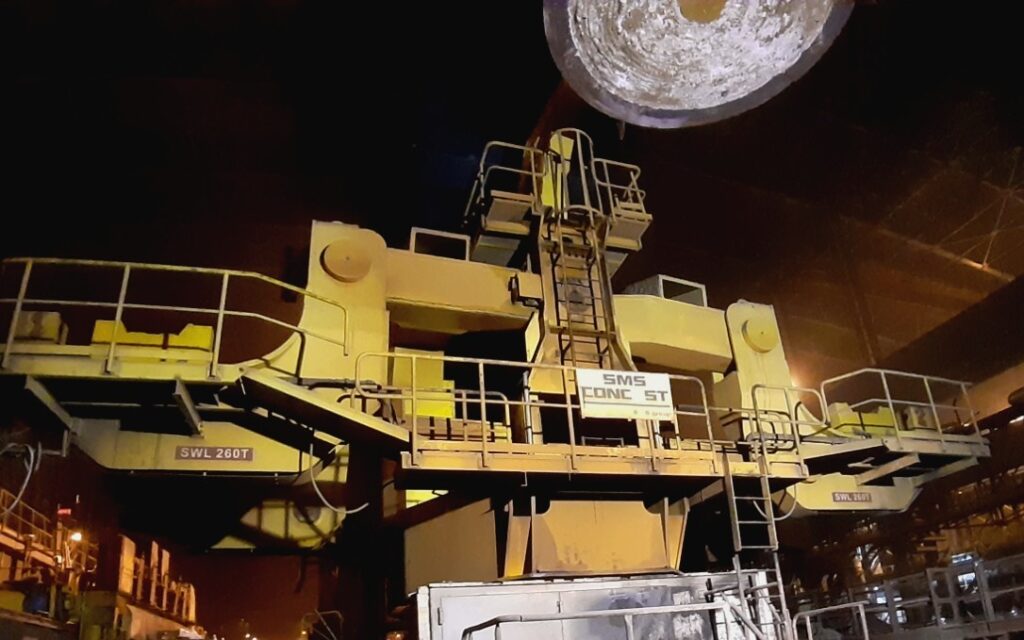Ladle Shroud and Collector Nozzle Engagement in Continuous Casting
Ladle turret can be butterfly type with two lifting arms where individual lifting facility is provided for smooth operations. The lifting /lowering is done by standard hydraulic cylinder and load cell weighing facilities are provided to monitor the flow of the metal from the ladle to the tundish.
Ladle cover movement is done by manipulator which has a hydraulically actuated arm extending from the center of the ladle turret to the center of the ladle. Lifting/Lowering is done with the help of a hydraulic cylinder. A single or dual ladle cover manipulator can be installed depending on the machine provider. Dual cover has an advantage over a single cover because it prevents temperature loss from both ladles rather than a single one.
Ladle Shroud Manipulator is a pneumatically actuated semi-automatic type . Manually operated swiveling and tiltable with an integrated supply line for argon gas feeding into the shroud is provided and the pneumatic cylinders provides the force to press the shroud against the collector nozzle. Also, counterweight are further added to press shroud additionally against the ladle nozzle.
The ladle rotation is brought about by an induction motor of 37KW power which is sufficient to rotate ladles of each arm of 150T each. The encoder provides the actual turret position. Encoder value is calculated from the data provided by the motor (like the speed, time, etc). The program is made in a manner that the slowdown of the speed takes place just before attaining the home position. Sometimes wrong feedback and errors can lead to stopping the turret in an undesired position. The position can be further reset by rotating the turret several times in automatic mode. A pneumatic brake is engaged to restrict further movement from the home position
Generally, three modes are provided for rotation: 1. Auto mode,2.Manual mode,3.Emergency mode.
1. Auto mode-rotates The turret automatically and stops at 180-degree position. Some working interlocks have to be cleared to enable auto rotation.
2. The manual mode-The operator takes the control of the movement and the rotates the turret in a clockwise or anticlockwise manner with the help of a manual lever and can stop the turret at his desired position.
3. Emergency rotation-It takes care of emergency situations like ladle or slide gate breakouts and moves the turret to the charging side. The speed of rotation is generally kept a little higher. On pressing the emergency button the slide gate automatically closes and the turret rotates without even achieving the top position.(the shroud and manipulator may get damaged if they are attached to the ladle at the time of pressing the emergency button).
Slide gate auto control-The slide gate auto control relies on the load cell of the tundish. The slide gate movement is manipulated according to the throughput from the tundish. The command for slide gate opening/closing will be given depending on the rise or fall in the tundish level. (ex-A throttle command will be given for every 0.5T fall or rise of weight in tundish).Errors or erratic values or abrupt rise or fall in load cell values will lead to chocking of ladle or overflow from the tundish. However, the operator can manually open and close the slide gate from the operating pendant and regulate the tundish level by visually observing the level. (Too much bath level fluctuations would lead to loss of metal temperature in the tundish).
Emergency stop button-It is provided to freeze all operations and no buttons on the pendant will work thereafter.
Operating pendant- The operating pendant has turret rotations buttons for auto,manual and emergency conditions, slag detection indicator, buttons for slide gate opening/closing, emergency stop, ladle lifting/lowering, ladle cover manipulator lifting/lowering and clockwise and anticlockwise movement button and manual arm selection.
Ladle turret rotational circle diameters range from 8 -15 m depending on the ladle size. In order to overcome the problem of longer casting times, the ladle turret are provided with integral electric arc ladle heating system Two graphite electrodes of 300 mm dia are able to assist in the temperature rise by 0.5 degee C/min from an installed load of 2500kVA.During the entire process the steel is stirred periodically to ensue temperature homogenisation in the bath.
Provisions for emergency rotations by the help of pneumatics is present to assist the movement in case of power failure or failure of encoder and other emergency conditions.
When encoder position fails, the pneumatic rotation can be used for proper positioning of the ladle which avoids unnecessary spillage and jam formation in tundish.
The amount of load the arm can sustain is declared by the provider and it is better to conform to the safety standards value. It can vary from 50-200T.Provisions for cooling of the slide gate cylinder with the help of nitrogen is also installed in the turret.
The load cell should be calibrated from time to time to prevent slag from getting into the tundish where slag detection devices are not available and physical observation to differentiate between metal and slag is the only technique that is applied.
200 bar line pressure in maintained in the hydraulic line for movement of the slide gate cylinder (Slide gate Plates).
Functions:
· Serves as a resting place for the new heat and provides extra time for ladle treatment.
· Reduces ladle change over time.
· Facilitates uninterrupted casting.
· Hydraulic lines installed in the ladle helps in the opening/closing of the slide gate cylinder.
· Saves the machine in case of emergency situations.
Handles Emergency situations:
In case of ladle through conditions or slide gate plate failure, emergency rotations of the turret move the ladle away from the casting positions to the charging positions and thereby protects the machine from severe damage.

© Metal world insight
Source: https://metalworldinsight.com/ladle-turret-and-its-operations/
0 Response to "Ladle Shroud and Collector Nozzle Engagement in Continuous Casting"
Post a Comment